Over the course of the next few articles I will try familiarize everyone with how to use the displays and signage on train station platforms in Europe to allow you to look like a pro when your train pulls into the station...
Today we'll take a look at the letters and numbers generally mounted above and next to the tracks on passenger platforms and how they show passengers where to be to catch their train. The first part, the number, is fairly self-explanatory. It represents the track next to it as a number in ascending order from the station. So track 1 would be closest to the station building, track 2 would be next to it, etc. Note, however, that in some cases a very high number, like track 21, might actually be closer to the station building than 21 tracks out, but we'll stick with the most common situations for the purpose of these articles.
The station departure board above lists only the track / platform for the first two trains. Why is that? In some countries and/or stations the track number isn't shown until shortly before the train arrives. That's to allow just about any train to leave from any track. In some countries and/or stations the same trains always leave from the same track, so it's not necessary to hold off on showing the track number. But in either case if a track number is showing it's a safe bet that's where your train will be departing from. Okay, so now that we know which platform to be on for the track, let's take a look at the other half of the signage in the first image of this article, the letter.
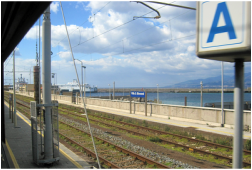
The letters that appear above the platform represent different segments of the platform that help passengers know roughly where to stand when the train rolls in. Today I'll explain how to know roughly where to stand if you are in first class or second class, and where to stand if you'd like a cold, refreshing beer from the dining car for the start of your journey. In a future article I'll explain how to identify where a particular coach will stop if you've made reservations. But for now we'll just get you to the right part of the train...
Near the track number and platform segment display is usually a flip-type or digital display board that provides information on the next train coming in on that platform. This is where we'll identify where to be when the train comes to a stop to quickly get on board and not have to drag luggage the length of the train to find an open seat in the right class. An insider tip: it also shows us where the end of the train will be, and as a pro will tell you, the ends of the train are where the coaches are the emptiest!
There are a few items of interest on the board to note. First is the train number and train type. This display shows a French TGV (France's high-speed train) with train number 9576. Its final destination is Paris Est, and it's making intermediate stops in Karlsruhe and Strasbourg. Not all stops will be displayed, usually only a couple. Now note the small symbol above and to the left of 'Paris Est'. This actually tells you where the train will be situated on the platform. It looks like this TGV will be stopping between sections D and G. Looking very closely at the display (it's hard to read in the image above) one can ascertain the number '2' underneath the 'E' and the number '1' underneath the 'G'. This tells us that second class will be located in sectors 'D' and 'E' and first class will be in sector 'G'. The dining car, which can be designated by the letter 'R' or sometimes as an icon of a coffee cup, sits between the two in section 'F'. Now imagine if you were waiting in section 'A' when this train pulled in for its 2-minute stop...

The destination board here provides information on a longer train. It shows a first class coach or two in sector 'B', it shows us that limited food service (in this case a 'Bord Bistro') is located in section 'C' and also shows that bicycles (or other larger equipment like wheelchairs) can be stored in a car in sector 'F'.
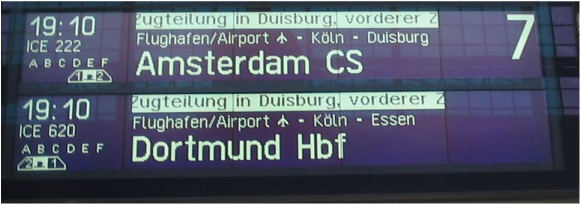
Here is one final destination board that will save you a world of grief if you know how to read it. Although fairly unusual, there are times when trains will take part of a journey coupled together, then split up at a particular station to continue to individual destinations. This is done most commonly on heavily trafficked lines where train density is high. When the train above pulls out at 19:10 it will run as one unit, but in Duisburg the train will split, with part of it headed west to Amsterdam and another part headed north to Dortmund. Thanks to your new knowledge, you should now be able to get into the right train to make it to either destination!
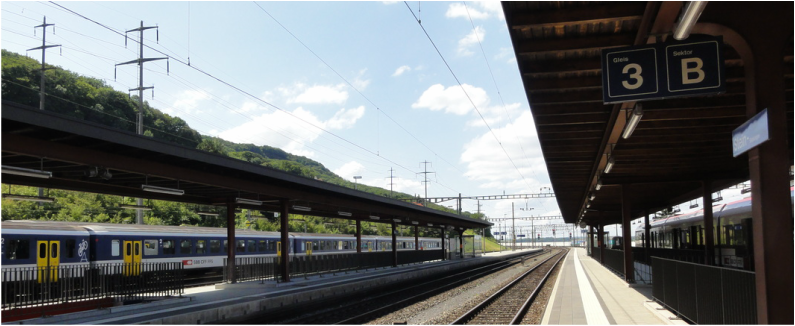

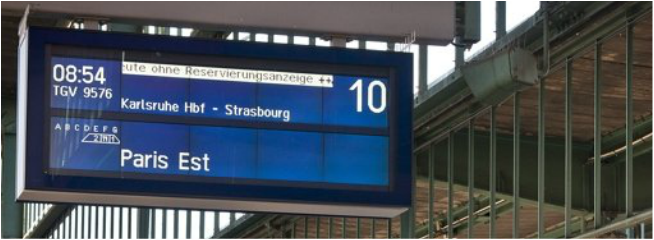
 RSS Feed
RSS Feed